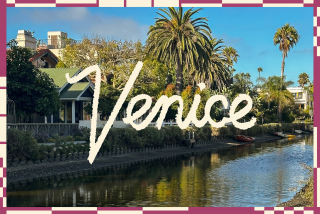It’s purely pedestrian
- Share via
Venice has its share of skateboard-riding, flip-flop-wearing, surf-loving, henna-tattooed residents, to be sure. But the true in-crowd resides a few blocks from that sandy scene in adorable, expensive, exclusive and small turn-of-the-20th-century cottages in the popular walk-streets section of town.
Beginnings
Like the canals district of Venice, the so-called inland walk streets were influenced by Abbot Kinney, a wealthy tobacco magnate and resort owner who strove to re-create the beautiful Italian city on the Southern California coast. Hence the neighborhood’s street names of Marco Place, Amoroso Place and Venezia Avenue, which actually are pedestrian pathways.
The first walk-streets enthusiasts arrived in the 1920s. They bought the humble Craftsman homes for their proximity to the Venice amusement pier, where many worked as entertainers and tradesmen. The neighborhood today attracts a galaxy of stars -- Julia Roberts is a walk-streets notable -- and the hip.
Many of the original properties -- small bungalows clustered together -- have maintained their character, despite gentrification of the neighborhood, said several longtime residents. But nearby Abbot Kinney Boulevard, where locals hang out in droves, was not always a place that attracted the wealthy.
“About 18 years ago, the area was pretty seedy,” said Suzy Frank, a longtime Venice resident and owner of Abbot Kinney Real Estate. “It mostly attracted hippies and artists who wanted to be close to the water.”
What it’s about
Leave your cars behind. They’re not allowed in this neighborhood of narrow pathways, elaborate gardens and eclectic home designs. A walking tour of the district bounded by California Avenue and Lincoln, Abbot Kinney and Venice boulevards reveals high-density living in relative seclusion from nearby suburban sprawl, a major draw to these unusual streets. Where mostly lower-income singles used to live, affluent families often reside today.
They’re not hermits, however. When they’re ready for Venice’s social scene, they walk just a few blocks to trendy Abbot Kinney Boulevard, which is lined with retail stores, restaurants, bars and art galleries.
At 10 a.m. on a recent Friday, pedestrians, some in sweat pants, others in designer apparel with newspapers tucked under their arms, ducked into Abbot’s Habit, a coffee shop and eatery, where locals and visitors people-watch from sidewalk tables.
Insider’s viewpoint
When Sparks Landen arrived in Venice in 1995, he had no idea how long he’d stay. Seven years later, he bought a house in the coveted walk streets, stepping back, he said, “100 years to a different way of living” when residents got around on foot in a country setting. Sure, the neighborhood has undergone major sprucing up, he said, but the juxtaposition of architectural designs is what attracted him.
On the market
The inland walk streets are made up primarily of 620 single-family homes, according to DataQuick Information Systems. A three-bedroom, three-bathroom home in 2,700 square feet recently was listed at $3.5 million. Up the block, a three-bedroom, two-bath home in 1,100 square feet was listed for $1.38 million.
Report card
Broadway and Westminster elementary schools scored 758 and 750, respectively, out of 1,000 on the 2006 Academic Performance Index Base Report. Mark Twain Middle School scored 623, and Venice High School, 671.
Historical values
Residential resales:
Year…Median price
1990…$313,500
1995…$225,000
2000…$445,000
2004…$857,500
2006…$1,175,000
*2007…$1,110,500
*Year to date
Sources: DataQuick Information Systems; api.cde.ca.gov; agent Doug Binder at Deasy/Penner & Partners; agent Betsy Goldman at betsysellsvenice.com.
More to Read
Sign up for Essential California
The most important California stories and recommendations in your inbox every morning.
You may occasionally receive promotional content from the Los Angeles Times.










